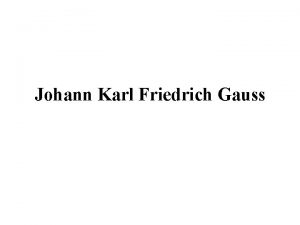Fiscal Transparency Code and Fiscal Transparency Assessment Johann











- Slides: 11

Fiscal Transparency Code and Fiscal Transparency Assessment Johann Seiwald Ljubljana, June 29, 2016

I. Lessons from the crisis Implications for Fiscal Transparency Standards Problem Weakness in Current Standards Recommendation Revisions to Deficits Infrequent fiscal reporting Monthly operational fiscal reports Quasi-fiscal Activity by So. Es Exclusive focus on general government Publication of fiscal data for public sector Unreported Flows Losses on asset & liability holdings not recognized Recognition of doubtful debts in summary aggregates Macroeconomic Shocks Bias in macroeconomic forecasting Alternative macrofiscal scenario analysis No recognition of contingent liabilities Recognition of quantifiable contingent liabilities Exposure to Financial Sector

II. Fiscal Transparency Code 2014 Objectives of the Revised Code 1. Comprehensive consultation of code and piloting the new framework 2. Emphasize the quality and reliability of published information rather than clarity of reporting procedures 3. Update the principles and practices to reflect the lessons of the recent crisis 4. Align the principles and practices with relevant international standards (GFSM 2001, IPSAS, OECD Principles, PEFA) 5. Provide countries with a set of achievable milestones on the way towards full compliance with international standards 3

III. Fiscal Transparency Code Architecture of the New Code 4

III. Fiscal Transparency Code More Graduated Set of Practices DIMENSION 1 FISCAL REPORTING Fiscal reports should provide a comprehensive, relevant, timely, and reliable overview of the government’s financial position and performance Coverage Fiscal reports should provide a comprehensive overview of the fiscal activities of the public sector Coverage of Institutions Fiscal reports cover all entities engaged in public activity that are delineated according to international standards. Coverage of Flows Fiscal reports cover cash Fiscal reports cover all Fiscal reports cover flows and all accrued cash flows and all government revenues, all cash revenues and accrued revenues expenditures, and financing. and expenditures and other and expenditures. economic flows. Coverage of Stocks Fiscal reports include a balance sheet of government assets, liabilities, and net worth. 1. 1. 2 1. 1. 3 PRINCIPLE PRACTICES GOOD # BASIC Fiscal reports consolidate all central government entities. ADVANCED Fiscal reports consolidate all Fiscal reports consolidate general government all public sector entities. Fiscal reports cover all Fiscal reports cover financial and non-financial all financial assets cash and all debt assets and liabilities, and liabilities. net worth. 5

IV. New Fiscal Transparency Evaluation: a. Summary Heatmap Costa Rica: Assessment Against Fiscal Transparency Practices 6

III. New Fiscal Transparency Evaluation: b. Fiscal Transparency Indicators: Fiscal Reporting Ireland: Fiscal Transparency Indicators Coverage of Public Sector Entities Reporting of Assets and Liabilities (percent of expenditure) (percent of GDP) Public corporations remain outside fiscal reporting Only a quarter of public sector liabilities reported

III. New Fiscal Transparency Evaluation: c. Fiscal Transparency Indicators: Fiscal Forecasting and Budgeting Bolivia: Source of Budget Forecast Errors Revenue Forecast Errors (Percentage point Contribution) Expenditure Forecast Errors (Percentage point Contribution) Means budgeted expenditure bears little relation to actual outcomes Massive underestimation of revenue in the budget

III. New Fiscal Transparency Evaluation: d. Targeted Recommendations: Ireland Principle 2. 1. 1 Budget Unity 2. 1. 2 Macroeconomic Forecasts 2. 1. 3 MT Budget Framework 2. 1. 4 2. 2. 1 2. 2. 2 2. 3. 1 Assessment Advanced: Budget is presented on a gross basis and budget documentation includes all general government entities. Importance Low: Own source revenue accounts for 2. 6 percent of total revenue which are presented gross in an annex. Medium: Real GDP growth forecasts have Advanced: The government publishes four an overestimating forecast error of comprehensive macroeconomic forecasts per 1. 0 percent of GDP in year t+2) and an year with explanations of all key variables and absolute volatility-adjusted forecast error of their composition and underlying assumptions. 0. 45 percent of GDP. High: Spending limits cover only 80 percent of the budget, tax expenditures and extrabudgetary funds are not included. 2. 1. Medium: Public investment is relatively low at 2. 6 percent of GDP. 2. 2. Low: Upward revisions by Parliament are low with 0. 3 percent of total expenditures on average. Good: Budget proposals are released 3 -4 Low: Budgets are routinely approved before Timeliness of Budget months before the start of the financial year. Parliamentary Documents but approved by Parliament only in December. amendments are limited. Investment Projects Fiscal Legislation Fiscal Policy Objectives Advanced: Budget documentation includes medium-term spending limits and revenue by ministry and economic category. Rec. Good: All major investment projects are subject to open and competitive tender and medium-term obligations are disclosed, but not all cost-benefit analyses are published before approval. Good: The Legal Budget Framework is comprehensive, but does not include a provision restricting legislature’s power to amend the executive’s budget proposal. Advanced: The government has several precise and time-bound national and supranational fiscal rules, some of them in place for more than 3 years, NAO and not Mo. F reports on compliance. High: Not all national fiscal policy objectives are consistently observed. CG gross debt is not on a declining path but will grow from 41 percent in 2010 to 49 percent in 2015. 2. 1. 9

III. New Fiscal Transparency Evaluation: e. Sequenced Action Plan Ireland Fiscal Transparency Action Plan Action 2013 2014 2015 2016 2017 1. Expand Institutional Coverage of Budgets, Statistics, and Accounts a. Present all gross revenues and expenditures of central government entities in budget documentation Incorporate NPRF into budget documentation Incorporate Non. Commercial Semi. State Bodies into budget documentation Incorporate all Integrate noncentral government commercial semientities in budget state bodies into documentation departmental votes b. Combine Finance and Appropriation Accounts into a consolidated Central Government Financial Statement Combine the information in the notes to the Appropriation Accounts to produce a summary report Combine Finance and Appropriation Accounts into a partial Central Government Financial Statement based on existing accounting policies Incorporate Non. Prepare Commercial Semicomprehensive Incorporate SIF and State Bodies into consolidated NPRF into partial consolidated Central Government provisional Central Government Financial Statement for audit by C&AG c. Provide an overview of the gross revenues and expenditures of the general government and its subsectors Reconcile gross revenues and expenditures of Exchequer and general government in budget Provide summary of gross revenues and expenditures of central government in budget Publish quarterly Publish monthly Provide summary of statistics on gross revenues and expenditures of central, local, and general government in budget sectors 10

IV. Fiscal Transparency Evaluation: Potential benefits for users • Country Authorities – A clearer picture of where they stand relative to international standards – A better prioritized and sequenced action plan for addressing reporting gaps – A wealth of data to use in starting to address those gaps • Citizens, Markets, and the International Community – A stronger evidence-base for the need for action to improve transparency – Facilitates cross-country comparisons of fiscal transparency practices – Identifying unknowns provides a stronger basis for risk assessment 11
 Busceral
Busceral Tilt assignment template
Tilt assignment template Ts ssaat
Ts ssaat Palimpses
Palimpses Vorwarts by johann dieter wassmann
Vorwarts by johann dieter wassmann Obama bush verwandt
Obama bush verwandt Archibald maclaren contribution in physical education
Archibald maclaren contribution in physical education Historischer hintergrund barock
Historischer hintergrund barock Lebenslauf johann sebastian bach
Lebenslauf johann sebastian bach Johann wolfgang döbereiner periodic table
Johann wolfgang döbereiner periodic table Johann sebastian bach prezentace
Johann sebastian bach prezentace Johann sebastian bach děti
Johann sebastian bach děti





















